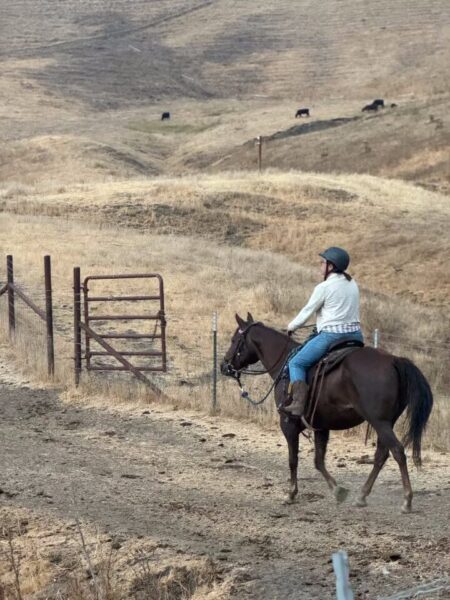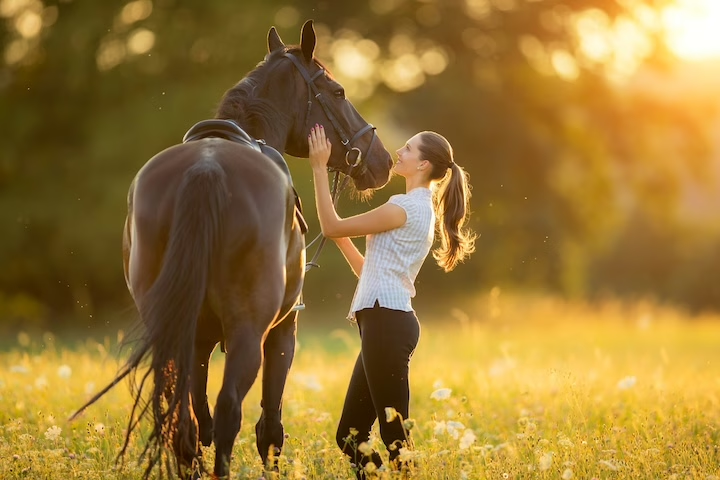Our family is keeping a horse this year. We are fostering a sweet, 19-year-old mare named, Jessie. I’m over the moon about her. In the past I have noticed some fascinating commonalities between learning/teaching a musical instrument and working with a horse. Caring for Jessie has highlighted that overlap with how I teach and approach music, and how I interact with Jessie.
Horses are more musical than you might think. The jingle of a rider’s spur can help them lock in trotting pace. Horses are musical animals in that they can find a rhythmic groove for their walking and trotting. I’ve discovered on walks we can pick a tempo and create an ensemble as I sing along to the 4/4 time percussion of her feet. She and I do great renditions of “I’ll Fly Away” and “You are my Sunshine.”
Posture matters. Whether you are trotting on a quarter horse or playing a fiddle, we try to keep a nice T shape: Tall back, shoulders not lifted or scrunched, weight distributed evenly. When riding, the goal is to keep an invisible line from the head/ear, to shoulder, hip and heel. With violin and viola, there is an invisible line that starts with the left toe and runs through the left elbow, and right up into the instrument. In riding, I need to hold the reins in such a way that my arms and the reins are an extension running from the bit in the horse’s mouth. When we ride, we follow the movement of the horse so that we are working together fluidly. In violin, the bow becomes an extension of the musician’s arm. Fluid movement is imperative, with no locked-up or straight joints. The moment we lock or straighten a joint, we lose that fluid extension either to the musical instrument or to the horse.
Crossing the Midline to come out of Fight or Flight. This works for people and it works for horses, too. When a horse gets stressed, one way to bring them back to calm is to turn them in a tight circle. This stops them from sprinting off (flight), and it also causes them to cross the midline as they turn their head and body to move in a circle. When we cross the midline, it requires both sides of the brain to communicate. That means the side that utilizes logic communicates with the side that initiates emotion. As the two sides collaborate we can step out of a “flight, flight, freeze” response and begin to be grounded in the present again. When a child becomes emotionally dysregulated, “crossing the midline” activities can help them calm their heightened nervous system response. With a child this could look like touching your right hand to your left knee, or giving yourself a big hug. Have the child draw a large figure eight in the air in front of them or on a chalkboard or other vertical surface. Or, bend the upper body side to side.
Self-Regulation Matters. Horses can sense when you’re frazzled. If you are upset or frustrated, they know it and it affects how they feel. In fact, equine therapy utilizes this- as people and horses can begin to match internal pace with each other and co-regulate. In short, I’m saying that taking a minute to slow my pace, lengthen my breaths, and starting our interaction with an open heart goes a long way with my horse. People can also be emotionally sensitive and in-tune. They sense the energy you bring into the room. With lessons and parenting, if I carry in an unrelated frustration, a young child may assume I’m frustrated with them. I’m hoping I can build on the habit of the pause that brings calm, peace and curiosity into my interactions.
Horses Remember. Humans do, too. Jessie is patient, calm and sweet. We have noticed a trend where she shows some anxiety when it is time to cinch her saddle. This is where I tighten up the belt that holds her saddle in place. We see her eyes and breathing change as she watches me intently. She shifts her weight and sometimes she chews on the wood of the barn joist if it’s within her reach. A horse trainer worked with me and noticed she has sore skin where she has been routinely cinched up tightly. As he felt in the tissues, he said he could feel some scar tissue telling the story she can’t tell, of tight and stressful cinching. Like horses, kids can’t always tell their story either. They may not be able to articulate or advocate for themselves. But their behavior may give you hints of past stress. I’ve learned with Jessie to go slow. I show her each item before I place it on her body. I cinch her gently and slowly as we prepare to ride. We make sure not to “over-cinch,” which would mean making it excessively tight. The trainer explained that because of her past experiences, even if I’m gentle, she is likely to be worried during cinch time. She remembers. In addition to taking my time, being gentle and allowing her to be aware of each step, my trainer suggested that this is the perfect time to give Jessie a horse treat. These treats are super yummy and I save them for special occasions. I get her all set up, and then give her that little nibble of treat right before I tighten her up. Then, she enjoys her treat and hardly notices my gentle cinching.
To summarize, we observe Jessie behavior and let it inform us of her needs and fears. I’ve done all I can to make the saddling process comfortable. I allow the horse to be fully aware of each step, and I break up the cinching into three gentle chunks instead of all at once. The last step is that we curate the environment. We pair something enjoyable or pleasant with the non-preferred task. People respond well to this, too. For the horse, it means a bite of horse-cookie. For an adult, it could mean savoring a delicious tea while they study. For a child, it may be that we play a music game in between doing chunks of the preferred task. Or, find a creative way to add more life, such as allowing the child to be the “teacher” in a role reversal, or allowing the child to create a chain of monkeys to demonstrate their repetitions of hard work. Or, if the activity is a specific skill like a shift, perhaps we could change the context of the skill. For instance, place the shift in a rendition of the Darth Vader theme melody. We can narrate the plan so the child fully understands what to expect. We can break it up into small, workable chunks. Remember, it is not about me- I’m gentle with the cinch. It is about a past story that Jessie can only communicate by her subtle, observable hints of anxiety or heightened concern.
Collaboration is key. Jessie tends to be scared of the water station where I bathe her. I think water puddles reflect sunlight there and that frightens her. She is a huge, strong animal. I can’t really force her to do something she doesn’t want to do. I need to ask, and if she is not up for it, her behavior lets me know. Then, I can do a little detective sleuthing to figure out what is wrong and how to compromise or adjust the plan. There is a pause to that, and a leaning in with curiosity rather than reacting. Pulling that lead rope will not move a 1,200 lb animal who doesn’t want to be moved. But even if she were on roller skates and I could pull her right over, is that really what we want? Forcing her to do it would mean she is in “fight, flight, freeze” mode, and can’t access her logic. I doubt that would be a successful experience, and we know she would remember it for next time. Instead, we pause, I look around. We find a solution. This week I figured out that if we approached the puddles from a different angle, she was okay with it. Maybe next time I will give any puddle a little sweep with the broom before I lead her over. We will gently and intentionally find solutions that work. Hopefully I can bring some of my approach to Jessie to teaching and parenting situations as well.
Warmly,
Christina


Leave a Reply